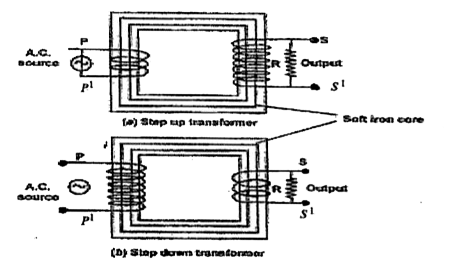What is the principle of a transformer ? Explain the theory and its application for long distance transmission of electrical energy.Solution in Punjabi
It consists of a rectantular soft iron core made of laminated sheets well insulated from each other. Two coils PP and SS of insulated copper wires are wound on the same core either on separate limbs of the core or on top of the other. These coils are well insulted from each other. The coil PP to which the source of alternating e.m.f. (to be transformed) is connected is called primary coil and the coil SS from which output electrical energy is drawn is called secondary coil. The secondary coil is wound closed to the primary, so that magnetic flux linked with each turn of the secondary coil is the same as linked with each turn of the primary.
In a step-up transformer, the primary coil PP consists of a few turns of thick insulated copper wire, whereas the secondary coil SS consists of a large number of turns of thin insulated copper wire.
In a step-down transformer, the primary coil PP consists of a large number of turns of fine insulated copper wire, whereas the secondary coil SS consists of a few turns of thick insulated copper wire.
Energy losses in transformer :
1. Copper losses :
2. Iron losses :
3. Hysteresis loss : This is the loss of energy due to repeated magnetisation and demagnetisation of the iron core when alternating current is fed to it. This loss of energy can be minimised by selecting the material of core, which has a narrow hysteresis loop.
Long distance transmission of AC with the help of transformer : For reducing I, a step-up transformer is used at the generating station. Such a transformer, as stated earlier converts electric power, at low voltage and high current to the same power at higher voltage and lower current. If I is sufficiently reduced, I2R would be negligible even when R is not very small. It means that we can use thin line wires for transmission in place of thick wires. By doing so, we will be able to save a large amount of material of wire and thus the cost of transmission is reduced. Hence, even if some I2 R loss and small amount of IR voltage drop may be there, at the city substation, the transmission ratio Ns/Np of the transformer can be adjusted suitably, so that voltage available for use can always be equal to the original value say, 220V.
Thus a transformer finds a most useful application in long distance transmission of electric power without much wastage.

Topper's Solved these Questions
- ELECTRICAL DEVICESBook:BETTER CHOICE PUBLICATIONChapter:ELECTRICAL DEVICESExercise:NUMERICAL PROBLEMS
Explore 3 Videos
- ELECTRICAL DEVICESBook:BETTER CHOICE PUBLICATIONChapter:ELECTRICAL DEVICESExercise:(MOST EXPECTED QUESTIONS 1 MARKS)
Explore 7 Videos
- ELECTRICAL DEVICESBook:BETTER CHOICE PUBLICATIONChapter:ELECTRICAL DEVICESExercise:SHORT ANSWERS TYPE QUESTIONS (3/4 MARKS)
Explore 5 Videos
- ELECTRIC FIELDBook:BETTER CHOICE PUBLICATIONChapter:ELECTRIC FIELDExercise:NUMERICAL PROBLEMS (MOST EXPECTED QUESTIONS)
Explore 4 Videos
- ELECTRICAL MEASUREMENTSBook:BETTER CHOICE PUBLICATIONChapter:ELECTRICAL MEASUREMENTSExercise:Most Expected Questions
Explore 7 Videos
Similar Questions
An electric motor operating on 50 V.D.C supply draws a current of 12 ampere. If the efficiency of motor is 30%, estimate the resistance of the motor.
View SolutionState the factors on which induced e.m.f. in a coil rotating in a uniform magnetic field depends.
View SolutionExplain principle and theory of Transformer with the help of diagram.
View SolutionA charged plastic spherical ball of mass 8.4×10−14kg is found to remain suspended in a uniform electric field of Entensity 5×102NC−1. Calculate the charge on the ball.
View SolutionWhy is a slide wire bridge also called a metre bridge?
View Solutionट्रांसफॉर्मर के अंतर्निहित सिद्धांत का उल्लेख करें | ट्रांसफॉर्मर के उपयोग से विद्युत ऊर्जा का लंबी दूरी तक बड़े पैमाने पर संप्रेषण कैसे किया जाता है ?
View Solutionट्रान्सफॉर्मर क्या है ? इसका सिद्धान्त समझाइए ।
View SolutionState the underlying principle of a transformer. How is the large scale transmission of electrical energy over long distances done with the use of transformer?
View Solutionट्रांसफॉर्मर क्या है? इसका सिद्धान्त समझाइए।
View SolutionExplain the use of transformer in long distance transmission of electric power .
View Solutionलंबी दूरी तक विद्युत ऊर्जा के संचरण एवं वितरण के लिए • ट्रांसफॉर्मर का उपयोग किस प्रकार किया जाता है ?
View SolutionExplain how transformer is used in long distance transmission.
View SolutionState the underlying principle of a transformer. How is the large-scale transmission of electric energy over long distances done with the use of transformers ?
View SolutionState the underlying principle of transformer. How is the large scale transmission of electric energy over long distances done with the use of transformers?
View SolutionState the underlying principle of a transformer. How is the large scale transmission of electric energy over long distances done with the use of transformers ?
View SolutionDraw a schematic diagram of a step up transformer. Explain its working principle. Deduce the expression for the secondary to the primary voltage in terms of the number of turns in the two coils. In an ideal transformer, how is this ratio related to the currents in the two coils ? How is the transformer used in large scale transmission and distribution of electrical energy over long distances ?
View Solution